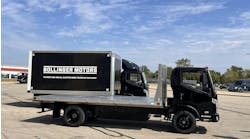MIT Center for Transportation and Logistics, utilizing data from Staples, found that the use of electric delivery trucks can cost between 9 to 12% less to operate than diesel-powered trucks.
However, the study noted, the cost of an electric truck can be triple that of a truck with a standard internal-combustion engine. An electric truck can cost nearly $150,000 compared to about $50,000 for the same type of truck with a standard internal-combustion engine.
“There has to be a good business case if there is going to be more adoption of electric vehicles,” said Jarrod Goentzel, director of the Renewable Energy Delivery Project at CTL and one of four co-authors of the new study. “We think it’s already a viable economic model, and as battery costs continue to drop, the case will only get better.”
Another of the paper’s co-authors, Clayton Siegert, a 2009 graduate of the CTL’s master’s of engineering in logistics program and a member of the Renewable Energy Delivery Project, presented the results in January at the IEEE Power and Energy Society Innovative Smart Grid Technologies Conference, in Washington.
The study uses data from Staples and ISO New England, the organization that runs New England’s electric power grid, to model the costs for a fleet of 250 delivery trucks. Researchers examined scenarios in which the whole fleet used one of three kinds of engines: purely electric, hybrid gas-electric and conventional diesel. They assumed each truck was driven 70 mi. a day for 253 days a year, with diesel at $4/gal.
The study found that the operational cost of an electric truck enabled to use a vehicle-to-grid (V2G) system is about 68 cents per mile, compared to 75 cents for internal-combustion trucks. Researchers added that most of the savings scale down to the individual vehicle, so companies don’t need big fleets to save money.
The study found that internal combustion engines averaged 10.14 mpg., compared to 11.56 mpg. for hybrids, and the electric-only trucks averaged 0.8 kilowatt-hours per mile.
The researchers also modeled a V2G system in which the truck batteries were plugged into the electric grid for 12 hours a night. They found that businesses could earn about $900 to $1,400 per truck per year in V2G revenues in current energy markets, equal to a 7 to 11% reduction in vehicle operating costs. Firms would also save on brake maintenance because electric trucks cause less wear and tear, they said.
In a V2G system, vehicle batteries are plugged into the electric grid overnight to enhance the electric system’s reliability, and the truck owners are paid by utility firms for their power services. The trucks help improve reliability because utilities can depend on them to plug in at certain hours – as opposed to electric passenger vehicles, which consumers plug in at more random times.
MIT says several utility companies are testing V2G systems.
Staples’ director of fleet equipment, Michael Payette, said the MIT analysis corresponds with his company’s findings so far, although it is still early in Staples’ post-deployment analysis. He also said he was surprised by drivers’ response – not only do they accept the electric trucks, they say they don’t ever want to drive diesel again.
Staples currently uses 53 all-electric trucks from Smith Electric Vehicles in several U.S. cities. Last July, it joined the Obama administration’s National Clean Fleets Partnership, under which companies work with the Dept. of Energy to develop a comprehensive strategy to reduce petroleum and diesel use in their fleets.
At the time Staples said it had increased the fuel economy of its fleet by more than 20% since 2007 through fuel-saving steps such as automatically limiting truck idling to no more than 3 minutes and limiting the top speed of its vehicles to 60 miles an hour.


